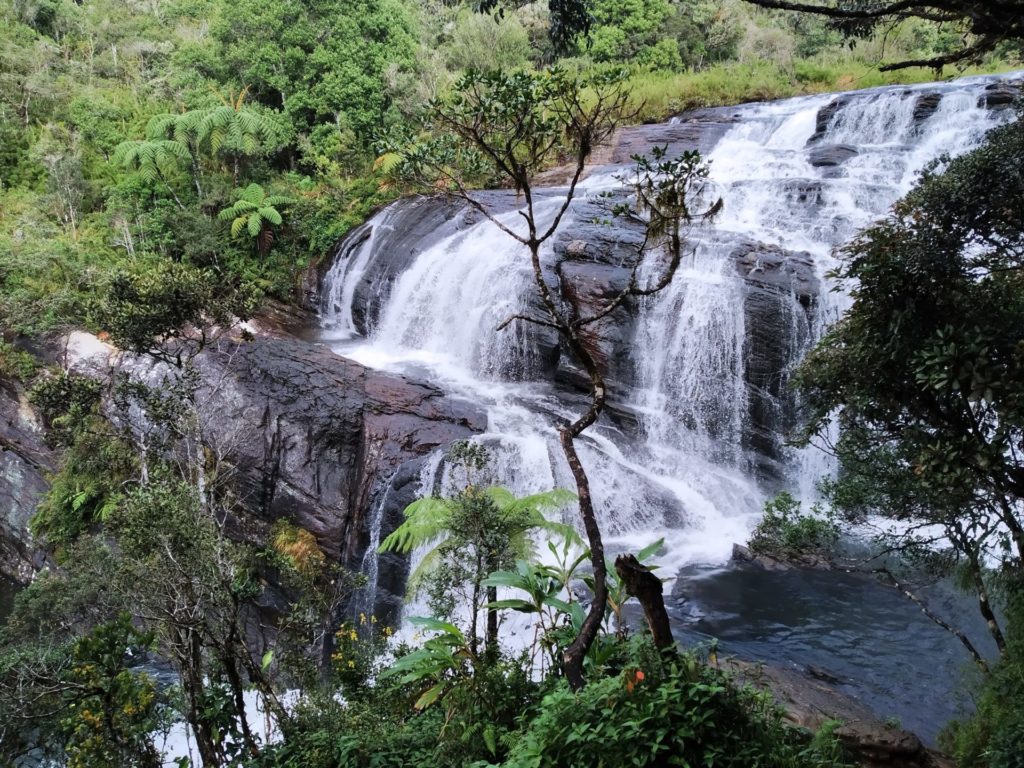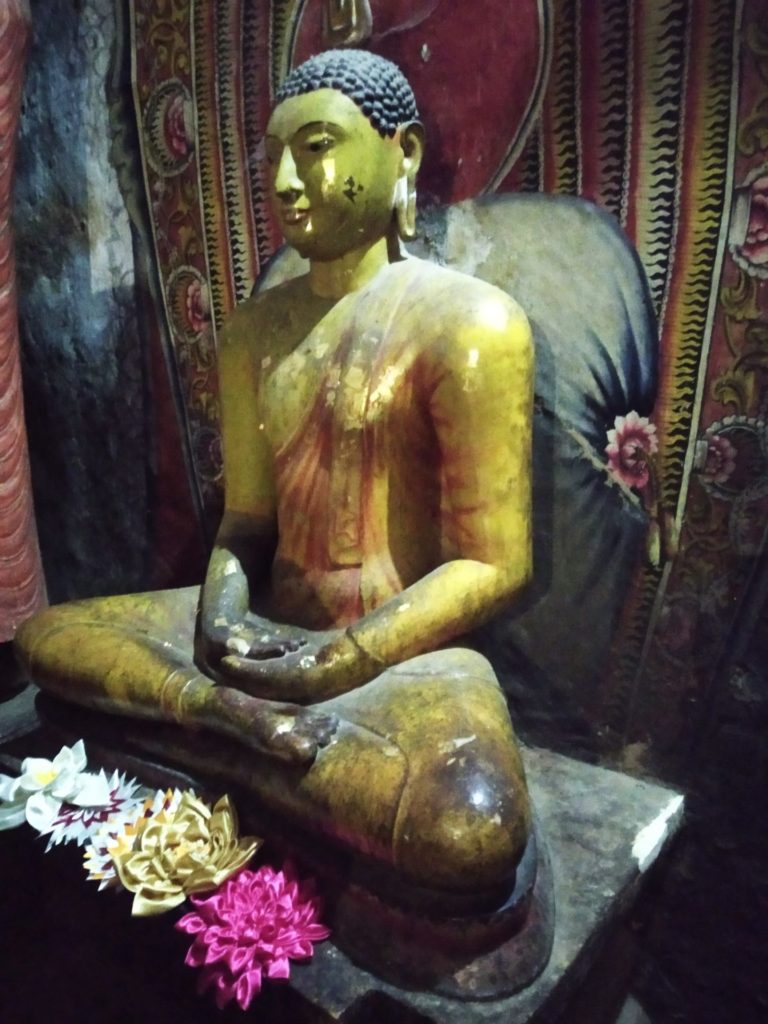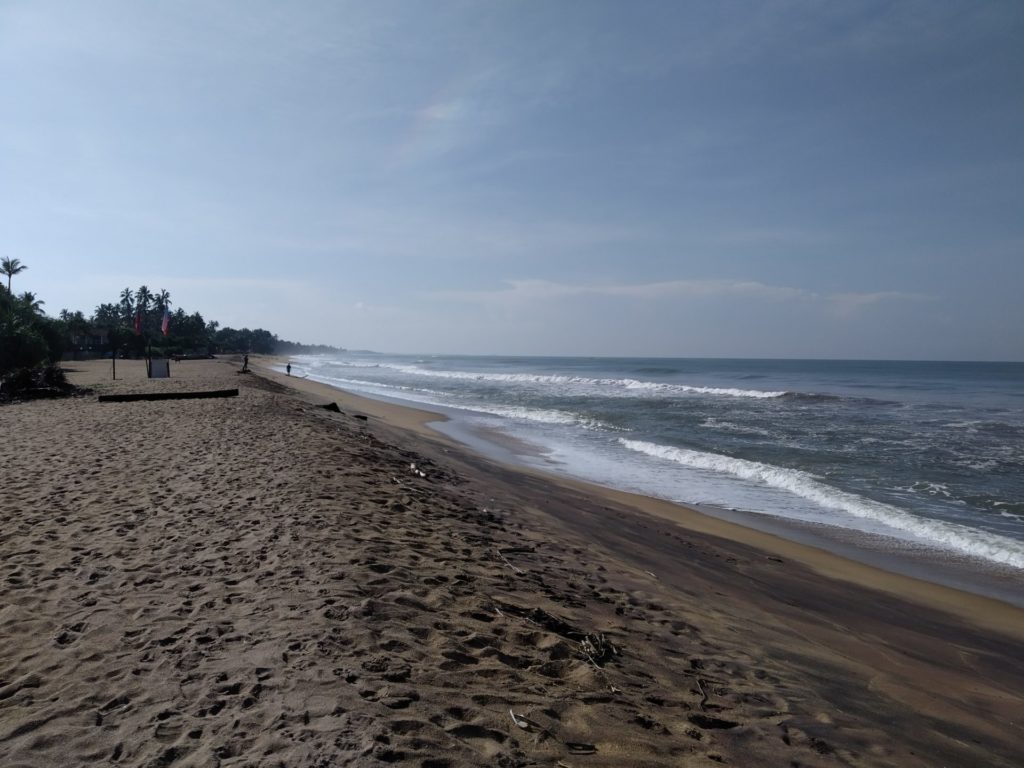- Ayurveda Retreats




overview
On this two-week yoga tour through Sri Lanka, we will use the first week to get to know Sri Lanka.
We will stay in a wonderful spa resort in the middle of The Cultural Triangle of Sri Lanka and from there we will make relaxing excursions in the surrounding area. The programme includes a tour of the famous Sigiriya Rock on foot and the historic town of Polonnaruwa by bike. In addition, we will take a cooking class with a family in the middle of the village and observe wild elephants in their natural habitat during a safari through the national park. Continue to the famous tooth temple in Kandy and by train through the wonderful tea plantations around Nuwara Eliya. Here we go on an early morning hike to the “World End” in Hortan Plains National Park.
Every day Sarah will offer at least one hour of yoga.
Afterwards we stay a week at Ayurveda Beach Resort with yoga lessons, healthy and tasty meals and naturally included Ayurveda treatments.
Program
Day 1 Arrival – Negombo
Distance: 8 km from the airport Time: 20 minutes
We land at Colombo Airport and are greeted here by our local tour guide and Sarah. A small transfer takes us to the beach of Negombo. Here we can relax for the rest of the day from the arrival and start with a small welcome yoga hour in our yoga holiday.
Accommodation: Goldi Sands, half board
Day 2 Negombo – Sigiriya
Distance: 145 km Time: 3, 5 hours
After a yoga class and a delicious breakfast, we drive to Sigiriya and visit the Sigiriya Rock Fortress as soon as we arrive. Sigiriya is rightly considered a UNESCO World Heritage Site, is Sri Lanka’s landmark and is the unofficial 8th Wonder of the World. From the monument itself, you have a wonderful view of a wonderful hilly green jungle. The huge lion thighs on the summit lead to the top of the stone heap, a palace in the sky. And when you step through the lion’s thighs, you can imagine entering the wide-open mouth of a lion carved out of the rock of Sigiriya that is no longer visible after so many centuries. The palace was a courtly paradise with elegant pavilions surrounded by gardens and pools.
The ascent to the summit provides a refreshing change after the long journey!
In the afternoon we check into our spa resort in the middle of the cultural triangle. An Ayurvedic application is highly recommended! A delicious dinner awaits us.
Accommodation: Pintaliya Resort & Spa, half board
Day 3 Sri Lankan cooking lessons in a traditional village and elephant safari in the afternoon
We start the day with yoga. Then we set off to a local family that lives on their small farm by a river. Here we will spend the morning to cook the extensive lunch with the female participants of the family. We can also get to know the traditional life of the people and have a look around the farm.
After a delicious and healthy lunch, we go on a safari through the Minneriya National Park to admire free-living elephants.
Accommodation: Pintaliya Resort & Spa, full board
Day 4 Polonnaruwa
Distance: 60 km Time: 1 hour
After our morning routine consisting of yoga and breakfast, we drive to Polonnaruwa, an hour’s drive away. Bicycles are already waiting for us here and we take a leisurely bike ride (approx. 25 km) through the peaceful countryside along a dam. After a little refreshment with a family, we return to visit the remaining ruins of the majestic city from the 11th century BC. The glory of its past heyday is still visible in the excavated and resurrected archaeological treasures. The rock-cut Buddha statues are particularly impressive!
In the afternoon we return to our Spa Resort, where we will spend the last night. How about a relaxing massage?
Accommodation: Pintaliya Resort & Spa, half board
Day 5 Polonnaruwa – Dambulla – Kandy
Distance: 140 km Time: 3 hrs 30 min
Today we start in the direction of Kandy. On the way we visit the famous Royal Cave Temple of Dambulla. The golden statues of the Buddha in the 5 caves bear witness to the reverence of Buddhists since time immemorial. The paintings on the walls will tell many stories from the past and the life of buddha.
Afterwards we visit a traditional spice garden in Matale and learn about Ayurvedic naturopathy. In the afternoon we reach Kandy and can take a walk through the small town before watching the ceremony in the sacred Temple of the Tooth.
Accommodation: Randholee Resort, half board
Day 6 Kandy – Nuwara Eliya
Distance: 75 km Time: 3.5 hours
Today, a very special highlight awaits us: By train we drive up to Nuwara Eliya, where the small train first slaps through dense jungle and then further and further up through a sea of green tea as far as the eye can see.
Once we arrive in the former British hill station, we visit a tea factory and in the afternoon we can visit the charming town with its markets.
Accommodation: Daffodils, half board
Day 7 Nuwara Eliya – Horton Plains – Beach
Distance: 220 km Time 6, 5 hours
Early in the morning we make our way to the famous Horton Plains National Park.
For nature lovers, the plains offer a diverse selection of fauna and flora. From the red flower that blooms in a corner behind a rock to the frequent sambar deer, the plain is full of biodiversity. In addition to the often discussed Sambar deer, there are elusive leopards that rarely leave their secret hiding places. This plateau is suitable for passionate bird watching and is home to some rare endemic species.
The 9.4 km long hike is a wonderful circuit through unspoilt nature. For those who complete the trek, a magnificent view awaits at the so-called “end of the world”, as it descends over 120 m steeply here! On a clear day, mountain ranges surround the visitor.
We then set off on the long drive to our Ayurveda beach resort.
Accommodation: Life Ayurveda Resort and Spa, full board
Day 8-14 Ayurveda Beach Resort
A regulated and relaxed daily routine consisting of two yoga classes a day, two hours of Ayurvedic treatments, delicious meals, beach stays and smaller excursions awaits us.
Accommodation: Life Ayurveda Resort and Spa, full board
Day 15 Beach – Airport
Distance: 75 km Time: 1.5 hours
depending on the time of our current flight, the transfer to the airport is on the agenda for today.
Included services
- German-speaking travel companion
- Local tour guide
- all accommodations in a double room with half board, In the Ayurveda Resort full board
- daily yoga
- all entrance fees for mentioned activities
- all transport in an air-conditioned vehicle
- during Ayurveda Resort stay: 2 yoga lessons, 2 hours of Ayurveda treatments daily
International flightVisa (free)personal expenses, gratuities, unmentioned meals
Highlights

Sri Lanka 
Sri Lanka 
Sri Lanka 
Sri Lanka 
World’s End 
Sri Lanka market 
Tea plantations 
Train ride Kandy 
Sri Lanka 
Buddha 
Cooking 
Enjoy the meal 
Temple 
Sigiriya Rock 
Beach 
Yoga 
Application 
Yoga 
Application
Prices and dates
Fixed date:
03.10.2025-17.10.2025
05.04.2026-19.04.2026
4-16 participants: 2100 € per person
Single room supplement: 400 €
Travel Info
requirements
Everyone is welcome on this yoga journey. The yoga classes are adapted to the level of the participants. The activities during the trip are moderate and very feasible with a healthy physical condition.
More information en
Travel guide and yoga teacher
To be announced
Sri Lanka
A visa must be applied for online for Sri Lanka.
We welcome you on a beautiful island in Sri Lanka. The proud history of the island of over 2500 years and the breathtaking variety of landscapes will conquer your heart and soul like no other destination. May the time you spend on the island be filled with exciting experiences.
What will impress you most about Sri Lanka is the amazing variety of landscapes. It is possible to create bright green rice fields, sun-tanned beaches, destroyed towns, small lively villages, near desert regions, wildlife reserves in tropical jungles and tea plantations in the hills literally within a few hours. Happen.
Ancient Sanskrit literature refers to Sri Lanka as “Sinhala” – the island of the Sinhalese. The people with this name have inhabited this island since the earliest history. Traditions recorded in Sri Lanka’s historical chronicles go back to the exiled North Indian prince Vijay and his entourage, who settled on the island and settled on the island in the 6th century. The Sinhalese kingdom was founded.
However, the oldest known civilization dates back to 380 BC, when Anuradhapura (205 km from Colombo) was founded as its first capital. After the advent of Buddhism in the 3rd century BC, a civilization rich in Indo-Aric culture developed. It produced the big cities with their “dagabas”, which compare the pyramids of the Egyptian palaces and amusement gardens, the rich art and architecture and the gigantic irrigation works, many of which are still in use today, and even in their size. Exceed.
With the invasion from neighboring southern India, the power base shifted to Polonnaruwa (101 km southeast of Anuradhapura) and to other cities such as Dambadeniya, Kurunegala, Kotte and Kandy. In the 16th century, with the arrival of the Portuguese in 1505, the island had its first known encounter with the merchants and colonial masters of the West. This was followed by a period of almost 500 years during which the island came under the control and influence of the colonial rulers Portuguese, Dutch and British. While the Portuguese and Dutch ruled the coastal regions for about 150 years, the British established complete control of the island with the fall of the Kandyan Kingdom in 1815. They, too, ruled for 150 years before the country became independent again in 1948. The effects of many cultures over the centuries have led to the rich diversity of the country’s culture, of which many testimonies are present today. The island’s economy is traditionally based on agriculture with rice as its main food. Spices such as cinnamon, cardamom, clove, nutmeg and pepper have been exported since time immemorial, as have precious stones and even peacocks and elephants. With Western commercial influence, Rice gave way to money harvesting until the British made tea the foundation of the economy. The new boost in the economy lies in exports to the export-oriented industry. Agriculture is now being revived. Non-traditional exports of clothing, seafood, foliage, cut flowers and tropical fish, as well as the value-adding agribusiness, have contributed to Sri Lanka’s economic progress in recent years.
The people of Sri Lanka have different races and religions. The majority are Sinhalese, who are Buddhists, while among the minorities the Tamils, mainly Hindus, are the largest, followed by the Moors who follow Islam and a sharply decreasing number of citizens descended from the Portuguese and Dutch, Christians are a considerable number of Christians among the Sinhalese and Tamils.
Although the country and its people are well on the way to modernization, they value most of their tradition. values and proud of their rich culture. One aspect that continues to attract visitors from abroad is the beauty and diversity of the landscape as well as the warmth and hospitality of the people.
Geography
An island of approx. 65,610 km2 Sri Lanka is located in the Indian Ocean off the southern tip of the Indian coast. It is located between 5 ° 55′ – 9 ° 55′ north of the equator and between the eastern longitudes 79 ° 42′ – 81 ° 52′.
Climate
Warm and beautiful all year round it is in Sri Lanka. Average temperatures are around 27 ° C in Colomb0 and decreases by about 10° towards the mountain region. The island has two rainy seasons: between May and July in the southwest and December / January in the northeast. Climatically, Sri Lanka does not have a low season. Brightly sunny warm days are the norm and are also common in the western season. Sea temperatures are usually 27 ° C.
Population
Nearly 20.97 million (2015), 7.5 Sinhalese, 11.9 SL Tamils, 4.6 Ind. Tamils 8.3 Moors, 0.3 Malaysians, 0.2 citizens and 0.2 others. Literacy rate averages 90.01 , one of the highest in Asia. (2001).
Religion
Predominantly Buddhism, but also Hinduism, Islam and Christianity.
Language
Understanding is rarely a problem, as English is understood in all parts of the country. Place names and signs are in the local language and often in English. Official languages – Sinhala, Tamil and English. National language – Sinhala and Tamil.
Time
Sri Lanka’s standard time is 5 1/2 hours before Greenwich.
Water
Filtered water and mineral water as well as bottled drinking water are available. The yellow king coconut is a popular thirst quencher and the most welcome drink is of course a hot cup of tea.
Packing:
Clothes
- light and airy clothing covering the body, especially in women should be covered shoulders and legs
- Clothes to change due to the warm and humid climate
- Headgear as sun protection
- For the mountain regions a light jacket and a sweater
- Raincape/Jacket
- Comfortable Yoga Clothes
- Swimwear
- light hiking boots, short hiking pants, breathable tshirt
- Sandals and/or flip-flops
Other
- Sunglasses
- Camera
- Pocket knife
- Travel pharmacy (water purification tablets, patches/dressing material, broad-spectrum antibiotic, anti-inflammatory cream, malaria profile axe, acute diarrhoea, medications for pain, fever and travel sickness)
- Insect repellent
- Mosquito net for Southern India
- Toilet paper/wet wipes (partly also available in India)
- Sunscreen
- Notebook
- Passport and visa copy
- Cash in Euro/ Traveller Checks




